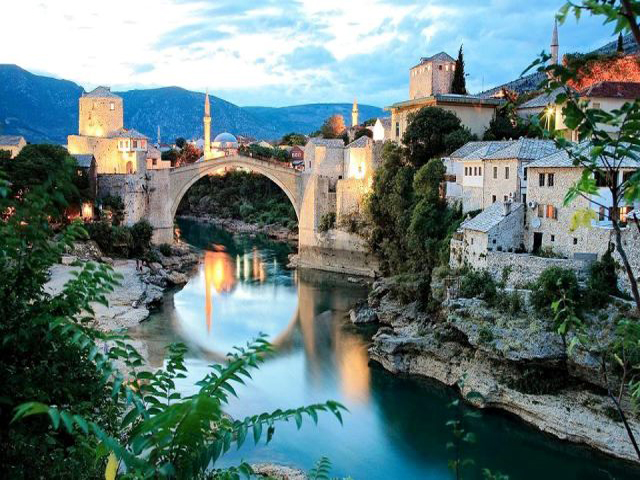To See in Mostar :
- Stari Most – The Old Bridge. Originally built by the Turks in 1566, it was destroyed in 1993, but rebuilt in 2004.
The bridge is the highlight of Mostar and is a UNESCO World Heritage Site. The bridge is 21m high and you will frequently see members of the Mostar Diving Club dive off the bridge. It is customary to give the divers a few KMs after they make the jump.
- Old Bridge Museum, (Next to the bridge). Includes exhibits on the history of the bridge, a panoramic view from the top, and entrance into the excavations below, along with a video detailing the reconstruction of the bridge. Entry: 5 KM.

- Muslibegovica House, (located near the Karadoz – Bey’s Mosque), . Open for visitors 15 April – 15 October from 10AM-6PM. Constructed 300 years ago, it is considered the most beautiful house from Ottoman period in the Balkans. The house is comprised of separate quarters for women (women’s courtyard– haremluk), and men (men’s courtyard – selamluk. Unlike earlier architectural styles, this house resembled a four-storey house built around the centre. Double-arched entrance with the central pillar reveals Mediterranean influence. The house preserved authentic monumental structure,
 items and documents providing an insight into the life of a wealthy bey family from the time. In addition to museum exhibition, visitors are invited to take traditional beverages or cookies, or spend a night in this authentic surrounding. Entry 4 KM – History Museum of Herzegovina. Open 8-16. Closed Mondays.. Has a small collection of photographs from various phases of Mostar history, including a small exhibit on a native son who appeared to have served as Tito’s former Foreign Minister for a space. Also shows an excellent video on the recent history of the Old Bridge. KM 5. edit KM 5.
items and documents providing an insight into the life of a wealthy bey family from the time. In addition to museum exhibition, visitors are invited to take traditional beverages or cookies, or spend a night in this authentic surrounding. Entry 4 KM – History Museum of Herzegovina. Open 8-16. Closed Mondays.. Has a small collection of photographs from various phases of Mostar history, including a small exhibit on a native son who appeared to have served as Tito’s former Foreign Minister for a space. Also shows an excellent video on the recent history of the Old Bridge. KM 5. edit KM 5.
- Koski Mehmed Pasina Dzamija (Koski Mehmed Pasha Mosque), (Old town). Small but simply pretty Ottoman mosque built in 1618. Climb to the minaret to see a great view over the town. Entry: 3 KM, with minaret access: 5 KM.
- Karadozbegova Dzamija (Karadjoz-Bey Mosque), (Old town.). A modest Ottoman mosque built in 1557. Entry: 3 KM, with minaret access: 5 KM.
- Cemetery, (next to Karadjoz/Bey Mosque in the Old town). A park turned into a cemetery in 1993 when the dead needed a place to be buried and other cemeteries were inaccessible due to the war.
- Biscevica House, Biscevica Street. An Ottoman house, where you only can see the few rooms in upstairs. 4 KM.
- Hum (Large Cross on Hill), (Go to west of town with outgoing road and go up switchbacks to paved path to top). 3. Long, boring hike along a busy road with no shoulder (or easy drive, Zita of hostel Nina offered to do it for 5€) leads to full view of Mostar sans old bridge and some of the southern part of town (a bit of a downward scramble through loose rock and potentially unexploded mines leads to that). Head west from the cathedral, then cut left at the white mosque. Follow that to a Muslim cemetery then up through a catholic cemetery to the inevitable switchbacks. Mine warnings are all over and no joke, there looked to be a somewhat recently triggered mine at the summit (slightly above cross just outside of what looked to be a dug-in fortification). Appreciation of view limited by history of use as sniper/artillery post during independence war and knowledge that construction of this massive religious icon came soon after end of conflict


